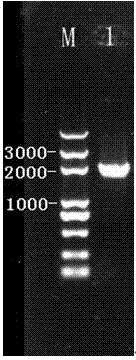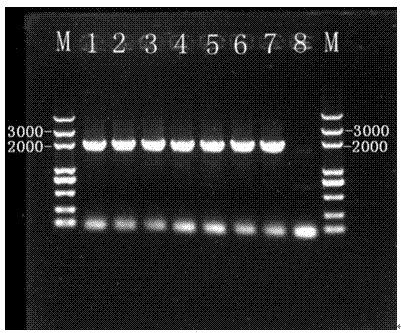Galactosidase and polynucleotide encoding galactosidase
A galactosidase and polynucleotide technology, applied in the field of β-galactosidase, can solve the problems of indigestion of lactose and affect the growth of suckling piglets, so as to improve the efficiency of feed utilization, treat the diarrhea of suckling piglets, reduce the Effects of production of toxins and enzymes
- Summary
- Abstract
- Description
- Claims
- Application Information
AI Technical Summary
Problems solved by technology
Method used
Image
Examples
Embodiment 1
[0019] Example 1: Cloning and expression of β-galactosidase
[0020] 1. Cloning and expression of galactosidase
[0021] 1. Sample metagenomic DNA extraction
[0022] (1) Sample pretreatment
[0023] Fully oscillate the muddy water sample of 65℃ hot spring to mix the muddy water evenly. Take 30 ml of the sample and centrifuge at 500g for 5min to make most of the sediment in the sample settle, remove the precipitated sand, and then centrifuge the remaining solution at 1000g for 10min. The purpose of discarding the precipitate is to further remove the relatively small impurities carried in the sample. Finally, centrifuge the suspension containing the bacteria at 5000 g for 10 minutes, discard the supernatant and collect the precipitated bacteria.
[0024] (2) Metagenomic DNA extraction: Qiaamp dna mini kit was used to extract DNA, and the method was carried out according to the kit instructions;
[0025] ①Use an appropriate amount of TE buffer (20 mM Tris-HCl, 2 mM ED...
Embodiment 2
[0080] Embodiment 2: the activity analysis method of galactosidase and some enzymatic properties
[0081] 1. Exploration of the enzymatic properties and enzyme activity of galactosidase (GAL)
[0082] Dilute the substrate o-nitrophenyl β-D-galactopyranoside (ONPG) with phosphate buffer (NaCl 8g, KCl 0.2g, NaCl 2 HPO 4 1.42g, KH 2 PO 4 0.27g, dilute to 1L, pH7.4) to make a solution with a concentration of 20mmol, take 10μl of enzyme solution and add 2ml of ONPG solution, take it out immediately after 30min in water bath at 37°C, place it in ice water to cool, and add 4ml of 0.5M / L Na 2 CO 3 solution to terminate the reaction. The blank sample is to add 10 μl of high-temperature inactivated crude enzyme solution to 2ml ONPG solution, take it out immediately after 30 minutes of water bath at 37°C, and place it in ice water to cool, and at the same time add 4ml of 0.5M / L Na 2 CO 3 Solution, measure the absorbance at 405nm.
[0083] 2. Optimum reaction temperature of ga...
PUM
 Login to View More
Login to View More Abstract
Description
Claims
Application Information
 Login to View More
Login to View More - R&D
- Intellectual Property
- Life Sciences
- Materials
- Tech Scout
- Unparalleled Data Quality
- Higher Quality Content
- 60% Fewer Hallucinations
Browse by: Latest US Patents, China's latest patents, Technical Efficacy Thesaurus, Application Domain, Technology Topic, Popular Technical Reports.
© 2025 PatSnap. All rights reserved.Legal|Privacy policy|Modern Slavery Act Transparency Statement|Sitemap|About US| Contact US: help@patsnap.com



